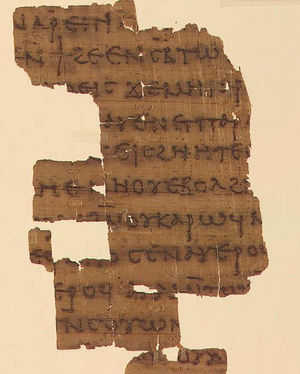Gnosticism
A term used to describe a diverse group of sects within Christianity that flourished in the second century, before the canon, doctrine and creeds of the Church were solidified. The Gnostics claimed to possess an advanced teaching that had been secretly handed down to them from Jesus and his close circle of disciples.

Some Gnostics offered a radically different view of Jesus’ role and mission than did the churchmen of their day. Because the teachings of the Gnostics challenged the unity of the growing orthodox Church, Church leaders banned, suppressed and almost totally destroyed their scriptures.
Gnostic beliefs
Even among the Gnostics, there were differences in beliefs and practices. Some were strictly ascetic; others were accused of being morally licentious. Some were celibate; others were not. But they did share some common beliefs. They believed that the means to salvation was not simply through faith, as the emerging orthodox contingent claimed, but through gnosis—a Greek word meaning “knowledge” or “acquaintance.” The Gnostics emphasized a personal knowledge and experience of the Divine. They believed that the quest for self-knowledge would lead to reintegration with the divine Self that is the essence of our identity.
An early collection of wisdom sayings found at Nag Hammadi, called the Sentences of Sextus, instructs: “A good man is the good work of God.... A man who is worthy of God, he is God among men, and he is the son of God.”[1]
In the Apocryphon (Secret Book) of James, Jesus says, “Verily I say unto you, no one will ever enter the kingdom of heaven at my bidding, but only because you yourselves are full.... Become better than I; make yourselves like the son of the Holy Spirit!”[2]
The Gnostic Gospel of Philip describes the follower of Jesus who becomes “no longer a Christian but a Christ.” It says: “You saw the spirit, you became spirit. You saw Christ, you became Christ. You saw the Father, you shall become Father.”[3]
In the Gospel of Thomas, which claims to record the secret sayings of Jesus, the Master tells his disciples, “Because you have drunk, you have become intoxicated from the bubbling spring which I have measured out.... Whoever drinks from my mouth will become like me. I myself shall become he, and the things that are hidden will be revealed to him.”[4]
Significance
The Ascended Lady Master Thérèse of Lisieux comments on the significance of the teachings of the Gnostics:
- The Gnosticism that has been discovered in this "library in a jar" at Nag Hammadi in 1945 is certainly not the final word, is certainly not the perfected doctrine, but the elements within it reveal clearly that which was banned as heresy by the Church Fathers; and by their banning of this true teaching of Jesus, they have denied our Lord’s doctrine to all the faithful these seventeen hundred years or more.
- Know, then, beloved, that Christ has indeed long ago been put out of this Church and that Christ resides only in the pure hearts of those who are within it, and some of these pure hearts have risen to the position of pope and high office and some have been the humble of no particular stature. Therefore they in their hearts of fire rather than through an organization or a doctrine have kept alive the true Presence of Jesus [on earth and, coincidentally, within the Church].[5]
Sources
Elizabeth Clare Prophet, Kabbalah: Key to Your Inner Power, chapters 2 and 3.
Elizabeth Clare Prophet with Erin L. Prophet, Reincarnation: The Missing Link in Christianity.
- ↑ Sentences of Sextus 394/395, 376a, in James M. Robinson, ed., The Nag Hammadi Library in English, 3d ed., rev. (San Francisco: Harper and Row, 1988), pp. 508, 507.
- ↑ Apocryphon of James 2.29–33; 6.19–20, in Robinson, Nag Hammadi Library in English, pp. 31, 32.
- ↑ Gospel of Philip 67.26–27; 61.29–31, in Robinson, Nag Hammadi Library in English, pp. 150, 147.
- ↑ Gospel of Thomas, sayings 13, 108. Translation from Robinson, Nag Hammadi Library in English, pp. 127, 137; and Marvin W. Meyer, trans., The Secret Teachings of Jesus: Four Gnostic Gospels (1984; reprint, New York: Random House, Vintage Books, 1986), p. 37.
- ↑ Thérèse of Lisieux, Pearls of Wisdom, vol. 31, no. 39.
